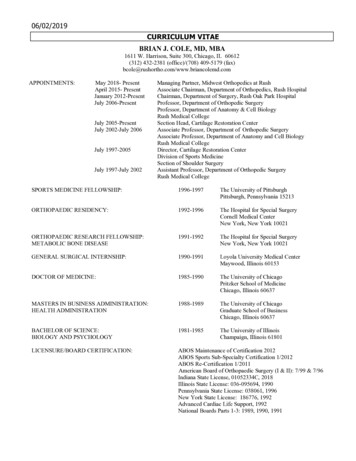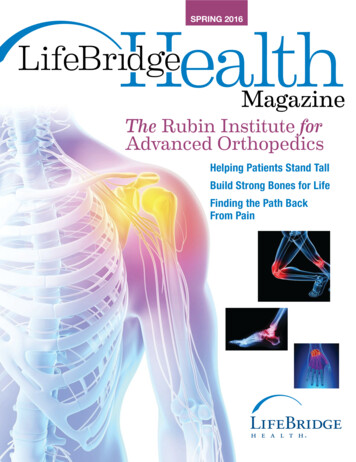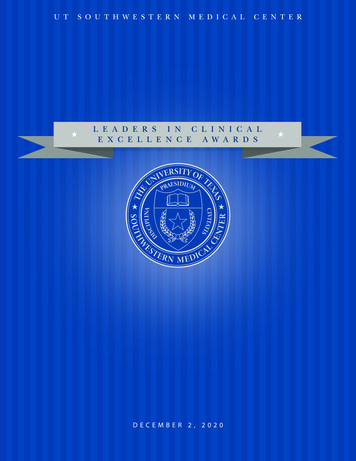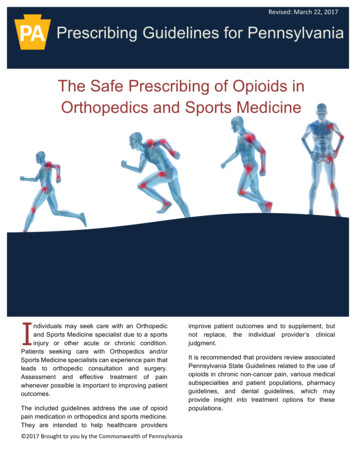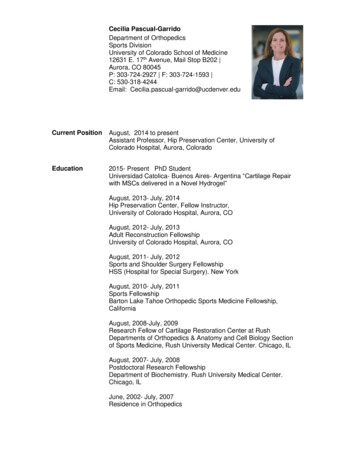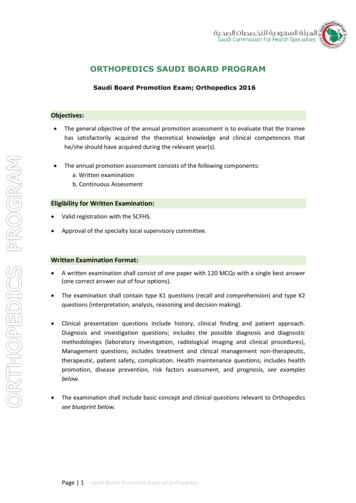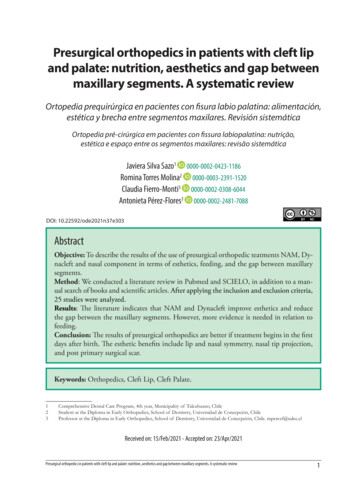
Transcription
Presurgical orthopedics in patients with cleft lipand palate: nutrition, aesthetics and gap betweenmaxillary segments. A systematic reviewOrtopedia prequirúrgica en pacientes con fisura labio palatina: alimentación,estética y brecha entre segmentos maxilares. Revisión sistemáticaOrtopedia pré-cirúrgica em pacientes con fissura labiopalatina: nutrição,estética e espaço entre os segmentos maxilares: revisão sistemáticaJaviera Silva Sazo1 0000-0002-0423-1186Romina Torres Molina2 0000-0003-2391-1520Claudia Fierro-Monti3 0000-0002-0308-6044Antonieta Pérez-Flores3 0000-0002-2481-7088DOI: 10.22592/ode2021n37e303AbstractObjective: To describe the results of the use of presurgical orthopedic teatments NAM, Dynacleft and nasal component in terms of esthetics, feeding, and the gap between maxillarysegments.Method: We conducted a literature review in Pubmed and SCIELO, in addition to a manual search of books and scientific articles. After applying the inclusion and exclusion criteria,25 studies were analyzed.Results: The literature indicates that NAM and Dynacleft improve esthetics and reducethe gap between the maxillary segments. However, more evidence is needed in relation tofeeding.Conclusion: The results of presurgical orthopedics are better if treatment begins in the firstdays after birth. The esthetic benefits include lip and nasal symmetry, nasal tip projection,and post primary surgical scar.Keywords: Orthopedics, Cleft Lip, Cleft Palate.123Comprehensive Dental Care Program, 4th year, Municipality of Talcahuano, ChileStudent at the Diploma in Early Orthopedics, School of Dentistry, Universidad de Concepción, ChileProfessor at the Diploma in Early Orthopedics, School of Dentistry, Universidad de Concepción, Chile. mperezf@udec.clReceived on: 15/Feb/2021 - Accepted on: 23/Apr/2021Presurgical orthopedics in patients with cleft lip and palate: nutrition, aesthetics and gap between maxillary segments. A systematic review1
ResumenResumoObjetivo: describir los resultados que seobtienen con el uso de ortopedia prequirúrgica NAM, Dynacleft y componente nasalen relación a estética, alimentación y brechaentre segmentos maxilares.Método: Se realizó un análisis de la literatura publicada utilizando bases de datos Pubmed y SCIELO, además de una búsquedamanual de libros y artículos científicos. Después de aplicar los criterios de inclusión yexclusión, se analizaron 25 estudios.Resultados: La literatura indica que NAMy Dynacleft mejoran la estética y disminuyen la brecha entre los segmentos maxilares,con respecto a la alimentación se necesitamayor evidencia.Conclusión: los resultados obtenidos conla ortopedia prequiríurgica son mejores sise empieza los primeros días de nacimiento. Dentro de la estética destaca la simetríalabial y nasal, proyección de la punta de lanariz y cicatriz post operación primaria.Objetivo: descrever os resultados obtidoscom a utilização da ortopedia pré-cirúrgicaNAM, Dynacleft e componente nasal emrelação à estética, nutrição e gap entre ossegmentos maxilares.Método: Foi realizada análise da literatura publicada nas bases de dados Pubmed eSCIELO, além da busca manual de livrose artigos científicos. Após a aplicação doscritérios de inclusão e exclusão, 25 estudosforam analisados.Resultados: A literatura indica que NAM eDynacleft melhoram a estética e diminuemo gap entre os segmentos maxilares, no quediz respeito à alimentação, mais evidênciassão necessárias.Conclusão: os resultados obtidos com aortopedia pré-cirúrgica são melhores se estase iniciar nos primeiros dias de nascimento.Dentro da estética, simetria labial e nasaldestacam-se a projeção da ponta do nariz e acicatriz pós-operatória primária.Palabras clave: Ortopedia; Labio fisurado;Paladar fisurado.Palavras-chave: Ortopedia; Fenda Labial;Fissura Palatina.IntroductionCleft lip and palate is one of the most frequentcongenital maxillofacial anomalies.(1) It ranksthird according to the Latin American Collaborative Study of Congenital Malformations, andits prevalence has increased. The cleft palaterate has increased from 0.4 (1982–1994) to 0.7(2001–2010) per 1000 births, and the cleft liprate from 1.2 (1982–1994) to 1.4 (2001–2010)per 1000 births.(2) In Chile, cleft lip and palateprevalence is 1.7 per 1000 newborns: approximately 400 cases each year.(3) Its incidence is 1.8per 1000 live births. Annually, this amounts toapproximately 452 new cases every year.(3)Its etiology is multifactorial, as it involves genetic and environmental factors that may in2terfere with the migration of neural crest cellsto the first branchial arch. Genetic factors appear in 20% to 25% of cases. Additionally, 2025% of patients present environmental factorssuch as vitamin A deficiency, corticosteroids,anticonvulsants, or a viral infection in the firsttrimester of pregnancy. No precise causes havebeen found in the remaining cases.(4)Facial development of the fetus occurs betweenthe third and twelfth week of pregnancy.(5) Between the fourth and ninth week, there is analteration in the migration or fusion of mesenchymal cells, which gives rise to the cleft lipbecause the frontonasal and maxillary processesfail to fuse. Furthermore, and not necessarily atthe same time, a cleft palate occurs when theOdontoestomatología 2021, 23 (38)
secondary palate fails to form, and the palatalshelves fail to fuse.(1)This anomaly can be diagnosed in utero withmodern technologies: an ultrasound scan in the16th week of pregnancy or during birth.(4)Cleft lip and palate may occur in associationwith other syndromic anomalies (20%) or inisolation (80%). It affects various orofacialfunctions such as feeding, hearing, phonation,breathing, self-esteem, esthetics, and social adaptation.(5) Therefore, this condition should beaddressed from a multidisciplinary perspectiveto provide comprehensive and long-term rehabilitation from birth to adolescence.(4) Careguidelines have been developed to restore fullrehabilitation, improve the appearance of compromised hard and soft tissues, and facilitatethe patient’s integration into society.(7-9)Predental and pediatric treatment can be divided into three phases: phase 1, from birth toaround 3 months of age (before any surgery);phase 2, from 3 to 12 months of age (after lipsurgery); and phase 3, from 12 months onwards(after primary palatal repair).(10)The modern school of presurgical orthopedics in cleft lip and palate treatment started in1950 with McNeil.(11) In 1993, Grayson et al.(12)created an intraoral plate with a nasal stentfor alveolar, lip, and nose modeling: nasoalveolar molding (NAM). In unilateral cleft lip andpalate cases, the clinician molds the greater alveolar segment towards the mid-sagittal plane,in the direction of the lesser segment.(13) Whenthe segments are less than 5 mm apart, the nasal component is added, which can be eithera stent (acrylic projection or wire extensionthat runs from the plate to the nose),(13) or aconformer, which is positioned in the affectednostril.(3) Presurgical treatment is completed atthe age of 5 months approximately, before theclosing of the primary palate. Then, the deviceis removed and the first surgery is performed.(6)Berggren et al. subsequently introduced a nasalelevator and paper tape to improve nasal morphology.(14) To avoid using of an intraoral plateand simplify the procedure, the paper adhesivetape is replaced with paper tape with an elastic band (DynaCleft , Canica Design Inc., Almonte, Ontario, Canada).(14) This elastic bandcreates muscular traction, bringing the cleft lipsegments together, thus reducing the width ofthe bone fissure. The treatment lasts for threemonths in patients with unilateral or bilateralcleft lip.(3)NAM is the most widely used technique inChile, and it was included in the Universal Access with Explicit Health Guarantees (AUGE)program in 2005.(3)This review aims to describe the results of NAM,Dynacleft, and a nasal component as presurgical orthopedics in terms of feeding, esthetics,and the gap between maxillary segments.Materials and methodsSearch strategy. We conducted a literature review in Pubmed (2000-2020) and SCIELO(2000-2020), in addition to a manual search ofbooks and scientific articles.Search terms. The following keywords were usedfor the search: cleft lip and palate, presurgicalorthopedics, presurgical nasoalveolar molding,congenital malformations, and breastfeeding.The following MeSH terms were used: CleftPalate, Cleft Lip, Palatal Obturators, with boolean operator AND.Inclusion/exclusion criteria. The following filters were applied: articles in English, Spanish,and Portuguese published from 2000 to 2020,case reports, clinical trials, cross-sectional studies, systematic reviews, editorials, and clinicalguidelines available in full text. Posters, lettersto the editor, expert comments, and partialtexts were not considered. The last search wasconducted on 3 September 2020. Articles describing studies that mentioned the most commonly used preoperative orthopedic methodswere considered: NAM, Dynacleft, and nasalcomponent (nasal stent, conformer, or shaper).We also included studies where the patients hadPresurgical orthopedics in patients with cleft lip and palate: nutrition, aesthetics and gap between maxillary segments. A systematic review3
complete uni or bilateral cleft lip and palate,who had started orthopedic treatment beforethe age of three months, and who had undergone orthopedic treatment for at least 100days. We excluded articles on presurgical orthopedic methods other than NAM, Dynacleft,and nasal component (nasal stent, conformer,or shaper), studies where the patients had additional structural and functional alterations (associated syndrome) and had undergone surgerybefore orthopedic treatment.Selection process. The articles were selected independently by two reviewers. The titles wereselected, and non-relevant publications wereremoved. The filters of each database were usedby selecting the “search by date,” “search forclinical trials,” and “search for articles,” options,mainly in PubMed and ScienceDirect. The degree of reviewer Kappa concordance was 0.96for article selection. The disagreements betweenthe reviewers were solved with additional discussion.Data collection. The following variables weresearched for in each article: 1. Feeding. 2. Esthetics (lip and nasal symmetry, nasal tip projection, and post-primary surgical scar). 3. Gapbetween maxillary segments.ResultsThe search strategy yielded a total of 235 articles. Fifteen additional articles were included after the manual search. Of the total, 103articles were eliminated because they were repeated. The complete articles were analyzed,and the inclusion and exclusion criteria wereapplied. This resulted in 25 studies to be analyzed, as shown in Fig. 1.Fig. 1: Article selection flowchartThe data was collected independently using Table 1.Table 1: Addressing each of the variables: feeding, gap between segments, and esthetics, by articleArticle No. Variables evaluated124FeedingGap between maxillary segmentsEstheticsNot mentionedPresurgical orthopedics aligns themaxillary segments, reducing gapwidth, and facilitating primarysurgery.Nasal stent: makes it possible to model the malformed nostril.Not mentionedNot mentionedNot mentionedThe use of nasal conformer in a newborn improvesalar symmetry.Odontoestomatología 2021, 23 (38)
Article No. Variables evaluatedFeedingGap between maxillary segmentsEstheticsGrayson-type orthopedicsimprove feeding. Mostchildren with bilateralclefts can eat correctlyand show substantialimprovement with the useof orthopedic plates.Grayson-type orthopedics progressively aligns the maxillary segments,retracts the premaxilla, and approximates the alveolar ridges.NAM uses a nasal extension to shape and reposition the deformed alar cartilage. In bilateral cleftlip cases, it lengthens the columella and supportsthe cleft nasal floor.4Not mentionedPreoperative orthopedics is essentialand widely used. In an effort toalign the three maxillary segments,lengthen the prolabium and the columella. NAM helps reduce the distancebetween the maxillary segments.Not mentioned5NAM contributes tobreastfeeding and childfeeding.NAM allows clinicians to redirect boneand soft tissues to a favorable anatomic position early. Primary lip surgerybenefits from reducing the width ofthe palatal and alveolar cleft.Preoperative orthopedics provides improved esthetic results, and primary lip surgery benefits fromreduced soft tissue tension. NAM achieves greatersymmetry of the lip, nasal cartilages,and improvednasal tip projection.6Presurgical orthopedicsfacilitates feeding.NAM aligns the alveolar processes,narrows the alveolar gap, shapes thealar cartilages, and brings the philtrumand columella into a better position.NAM improves nasal symmetry in unilateral cleftcases, and elongates the columella in bilateralcases.The most significant benefit is repositioningthe columella from an oblique position to a verticaland midline direction. This results in better nasaltip projection, and symmetry of the alar cartilages.The nasoalveolar modeling plate isused in practice with good results ingaps from 3-8 mm to 14 mm.This technique minimizes scarring, and in patientswith bilateral clefts, it eliminates the need for asecond surgery to elongate the columella, whichcauses scarring at the columella-labial junction.NAM reduces the distance betweenlabial segments, allows for growthstimulation and redirection in orderto reposition alveolar segments in acontrolled manner.NAM improves esthetic appearance and nasalsymmetry without affecting nasal growth.37NAM improves feeding.Orthopedics aligns the three maxillarysegments of patients with bilateralcleft lip and palate.The cases presented (case 1 and 2) show minimalor almost no scarring, and almost normal anatomyof the lip and palate was achieved.CASE 1: patient with unilateral cleft lip and palatethat has been treated with NAM for three months.The nose has not changed significantly becausethe child was already three months old when thecondition was reported.8Strong evidence indicatesthat preoperative orthopedics does not improvethe efficiency and effectiveness of breastfeeding.Since there is no evidence in favoror against preoperative orthopedics,we suggest that the treatment beprescribed according to the surgeon’sexperience.The expert committee agrees that the resultsof preoperative orthopedics in nasal symmetrydepend on the treating professional’s skills andexperience.One study reported pressure ulcer as an adverseeffect. Therefore, the authors state that no conclusions can be drawn on the usefulness of preoperative orthopedics from the studies reviewed.Presurgical orthopedics in patients with cleft lip and palate: nutrition, aesthetics and gap between maxillary segments. A systematic review5
Article No. Variables evaluatedFeedingGap between maxillary segmentsEsthetics9Presurgical orthopedicsfacilitates feeding.Presurgical orthopedics reduces theFurther studies are needed.gap and repositions the maxillarysegments. However, some peoplebelieve that it is not necessary and thatthe advantages of monitoring the cleftpatient (rather than treating orthopedically) and of surgery are greater.10In the first few days, theinfant may need time toget used to feeding withthe NAM method.NAM reduces the severity of the initialgap between maxillary segments.Good alveolar alignment helps thesurgeon to achieve a better and morepredictable surgical result, in additionto a successful gingivioplasty.Long-term studies of the NAM technique indicateimproved lip and nose shape, reduction of nasalfistula and lip deformities. This technique haseliminated the need for surgical reconstruction ofthe columella and the resulting scar in bilateralcleft lip and palate.The NAM technique has been shown to significantly improve the surgical outcome in primarycleft lip and palate repair compared to otherpreoperative orthopedic techniques.Long-term studies of NAM therapy indicate thatthe change in nasal shape is stable with less scartissue, and there is improved nasal and lip shape.11Not mentionedOne of the benefits of the NAMtechnique is proper alveolar, lip, andnasal alignment, which helps achievea better and more predictable surgicalresult.In unilateral cleft patients, the nasal stent usedjointly with NAM straightens the deviated columella toward the noncleft side. In patients with bilateral cleft lip and palate, the nasal stent elongatesthe columella by stretching the tissue gradually.Nasal shape and esthetics in cleft patients aresignificantly better in patients who underwentNAM treatment.Long-term studies of NAM therapy indicate thatthe change in nasal shape is stable.1213146Some orthodontistshave reported that NAMimproves feeding, speech,and occlusion.Sixty-five percent ofrespondents say that theDynacleft patch promotesinfant feeding.Not mentionedNAM can be used to approximate thealveolar segments.NAM can improve nasal tip projection and correctalar cartilage distortion and asymmetry.Closing the alveolar gap with an alveolar shaper reduces the nasal deformityso that more precise nasal shaping canbe implemented.The nasal stent can be used in bilateral cleft lip andpalate patients to lengthen the columella gradually. The columella thus created grows normally. Thiscreates a nasal tip with improved projection, thelateral alar cartilage is corrected, and there is anincrease in nasal mucosal surface.This new orthopedics (Dynacleft)The nasal conformer models and corrects themalposition of the nasal cartilage and the alar baseof the nose on the affected side, making the nosesymmetrical.Most parents believe that the estheticresult is excellent.brings together the segments of thecleft lip by reducing the width of thebone fissure with muscular traction.Dynacleft and Grayson’s NAM: bothmethods significantly decrease gapwidth.Both methods improve nasal asymmetry. Our findings show that both methods have similar results.Odontoestomatología 2021, 23 (38)
Article No. Variables evaluated15FeedingGap between maxillary segmentsEstheticsWith NAM, newborns cansuckle without nausea ordifficulty.NAM reduces the size of the alveolargap after molding and repositioningbone and soft tissue segments.Using NAM, deficient tissues can be expanded,and malpositioned structures can be repositionedbefore surgical correction.Initially, the gap was 6-mm wide, and NAM successfully rehabilitates the newborn byafter 11 weeks with NAM, it was 1-mm closing the oronasal communication.wide.16NAM precludes traditional Not mentionedbreastfeeding in almostall cases.Not mentionedHow infants undergoingNAM therapy breastfeed:75% used a Habermanfeeder, and 2% used thenipple.17Not mentionedNAM improves nasal angle symmetry Not mentionedin patients with unilateral and bilateralcleft lip and palate, and nostril span.18Not mentionedThe gap between maxillary segmentsdecreases.A significant improvement in esthetics was observed in patients who used NAM compared withthose who did not.19Not mentionedPNAM repositions premaxilla andalveolar processes.In this case, the nasal width decreased, thecolumella length increased, and the alar cartilageswere molded to a normal shape. The shape of therepaired nostril was the same as the opposite side,resulting in an appearance of facial symmetry.Post-surgery scars on the upper lip were barelyidentifiable.The results of this study show a significant decrease in the intra-alveolargap. The alveolar segments touched,and the labial segments were closertogether.NAM also includes support and modeling of the nasal cartilages, correctingnasal projection, and lengthening thecolumella before primary surgery.20Not mentionedNAM plays an essential role in reducingthe gap between segments andassociated nasoalveolar and nasaldeformities. Specifically, it has beenargued that NAM acts as an inductivemechanism to stimulate the activity ofimmature nasal chondroblasts. It leadsto interstitial expansion associatedwith improved nasal morphology.NAM can improve several essential features likenasal cartilage deformity and nasal asymmetry.It can also stretch the nasal mucosal lining andlengthen the columella without surgery, improvingappearance.21Not mentionedNot mentionedNAM minimizes wound healing disturbances andscar severity after surgery.Presurgical orthopedics in patients with cleft lip and palate: nutrition, aesthetics and gap between maxillary segments. A systematic review7
Article No. Variables evaluatedFeedingGap between maxillary segments22Presurgical orthopedictreatment in childrenwith cleft palate improvestongue function and facilitates newborn feeding.Presurgical orthopedic treatment seeks Presurgical orthopedic treatment aims to shapeto align the segments and reduce gap the nasal cartilages and reshape the columella. Thewidth to reduce soft tissue tension and durability of these effects is controversial.facilitate cheiloplasty.23Not mentionedIntermaxillary segments in patientswith NAM (CAD/CAM) and manualNAM decreased.Not mentioned24Not mentionedNot mentionedNot mentioned25Not mentionedAfter six months with NAM treatment,the posterior alveolar segments werealigned, and the premaxilla retractedinto the oral cavity. Three alveolarsegments were repositioned into theirproper shape within the arch, and thelips were brought closer together.Not mentionedAssessing risk of bias. The risk of bias of eacharticle was assessed according to The CochraneCollaboration (2011) guideline: 32% of the articles were low risk for “reporting bias,” while20% of the studies were of high risk, and 48%Estheticshad unclear risk (Fig. 2). The degree of biaswas classified as low risk if all criteria were met,moderate risk if only one criterion was missing, and high risk if two or more criteria weremissing.Fig. 2: Risk assessment8Odontoestomatología 2021, 23 (38)
Feeding: Ford(4) suggests that Grayson-type presurgical orthopedics initiated in the first monthof life improves feeding. Santiago et al. (13) andBravo et al.(6) agree. The latter study indicatesthat presurgical Orthopedics helps improvebreastfeeding and feeding in general. Avhadet al. (15) state that newborns can suckle without nausea or difficulties with NAM. Hechenleitner et al. (3) conducted a survey among theguardians of patients with complete unilateralcleft treated at the Gantz Foundation, Santiago-Chile. Regarding the use of Dynacleft andits effect on feeding, 65% stated it was better,and 35% that it was neither better nor worse.(3)Alperovich et al. (16) say that routine use ofNAM would not have a negative impact onbreastfeeding. However, the AUGE ClinicalGuide for cleft lip and palate 2015 (9) indicatesthat the use of presurgical orthopedics does notimprove breastfeeding efficiency or effectiveness.Esthetics: According to Bravo et al., (6) the nasoalveolar shaper allows for the early redirectionof bone elements and affected soft tissues towards a favorable anatomical position. Additionally, it has better esthetic and functionalsurgical results, achieves greater symmetry ofthe lip and nasal cartilages, and improves nasaltip projection.Santiago et al. (13) noted that nasal stents improve nasal tip projection and correct distorted and asymmetrical alar cartilage. Shetye (12)adds that they help to expand the nasal mucosal tissue lining. In patients with unilateralcleft lip and palate, the nasal stent straightensthe deviated columella towards the noncleftside. In patients with bilateral cleft lip andpalate, it lengthens the columella. This processtakes three to four months.(12) The nasal conformer models and corrects the malpositionof the nasal alar cartilage and the base of thenose on the affected side, providing good nasalsymmetry.(14)According to Nazarian et al., (17) the nasoalveolar shaper improves nostril width in bothunilateral and bilateral cleft lip and palate patients.In the study conducted by Broder et al., (18)caregivers of patients undergoing NAM therapy reported better postsurgical outcomes thancaregivers of patients without a nasoalveolarshaper, especially regarding nose appearance.Kamble et al. (19) evaluated nostril symmetry following NAM use with improved symmetry ofthe nose in height, width, and columella anglecompared to the initial presurgical stage andwith some relapse in nostril height (20%) width(10%), and columella angle (4.7%) at age 1.(19)Gap between maxillary segments: Monasterio et al. (14) compared the two preoperativeorthopedic techniques in 20 patients with unilateral cleft treated at Fundación Gantz, Santiago, Chile. Group A received treatment withthe Dynacleft technique and nasal elevator forthree months, before lip surgery. Group B underwent orthopedic treatment with the NAMGrayson technique for three months before thefirst lip and nose surgery. All the patients werenewborns. The results show that both preoperative orthopedic methods are effective. Thealtered nasal anatomy (increasing the angle ofthe columella) improves, and the width of themaxillary gap decreases in patients with complete unilateral cleft lip and palate.(14)Table 2 shows the articles evaluated. Table 3shows the data obtained from each article forfeeding, gap between maxillary segments, andesthetics. When the article does not includethese variables, “not mentioned” is entered. Thearticles that do not refer to any variable contextualize cleft lip and palate: its prevalence inChile and its classification according to severity.DiscussionThe comprehensive treatment of cleft lip andpalate patients is complex, and there are no rigid treatment protocols.(7) The results depend onthe plasticity and moldability of the neonatalcartilaginous tissues; the earlier orthopedicsPresurgical orthopedics in patients with cleft lip and palate: nutrition, aesthetics and gap between maxillary segments. A systematic review9
is started, the better the results.(15) The studies analyzed agree that the ideal time to starttreatment is within 72 hours of birth,(6) whencartilage and bones have a high concentrationof hyaluronic acid and can be easily molded.(4)Few studies have been found on feeding; Alperovich et al. (16) mention that most cleft lip andpalate patients cannot breastfeed naturally andthat they generally use a Haberman feeder—abottle for children with special needs. A surveyof parents of patients undergoing NAM treatment revealed that 75% use this feeder, while11% use another bottle. (16)Regarding the esthetic contribution of presurgical orthopedics, thirteen of the articles studied agree that they are beneficial. This is becausethese corrections reduce excessive scar tissue,making the surgical scar less visible or almostinvisible (6-8, 11, 15, 19-21). However, the durabilityof these effects is controversial.(22) The 2015AUGE Clinical Guide for cleft lip and palate (9)agrees that the results of preoperative orthopedics in nasal symmetry depend on the treatingprofessional’s skills and experience.The gap between the maxillary segments woulddecrease according to nineteen of the articlesreviewed, including those patients who usedNAM created with CAD/CAM technology.(23)The other five articles do not mention this variable, and the remaining article states that thereis no evidence in favor or against presurgicalorthopedics.(9)Advances in digital imaging technology, such ascomputer-aided design, computer-aided manufacturing and 3D printing, offer new alternatives to the orthopedic rehabilitation process.(24)The possibility of creating NAM devices with3D technology has many benefits, such as reducing the emotional distress of patients andfamilies due to the significant reduction in the10number of adjustments and treatment time.Additionally, treatment precision improves significantly.(21) 3D facial scanners, which have afast scanning speed compatible with the infant’smovements,(25) can be used to collect valuabledata on long-term growth effects, making thisorthopedic process more effective and efficient.(21)Ritschl et al. (23) compared two groups of patients with cleft lip and palate: one group treatedwith conventional NAM and the other treatedwith NAM created using CAD/CAM technology. The results showed no significant clinicalchanges between the two groups, suggestingthat CAD/CAM technology integration is aseffective as the conventional approach. However, resins compatible with NAM treatment arelimited since the material used for 3D printingmust not be harder than the polymer used forhand-built NAMs.(21)Presurgical orthopedics as a research topic islimited by the low number of existing randomized studies and the limited evidence onfeeding. Of the twenty-five studies evaluated,only twelve analyzed this variable. Practical limitations are the low number of orthodontiststrained in this procedure and its cost.(14)ConclusionNAM and Dynacleft improve esthetics and decrease the gap between the maxillary segments.The esthetic aspects include lip and nasal symmetry, nasal tip projection, and post-primarysurgical scar. Regarding feeding, more evidenceis needed. Results vary depending on treatmentinitiation time, which should begin within thefirst days of life.Further long-term prospective clinical trials areneeded to provide more evidence on the resultsobtained with preoperative orthopedics.Odontoestomatología 2021, 23 (38)
References1. Ford A, Tastets M, Cáceres A. Tratamiento de la Fisura Labio Palatina. Rev Med Clin Condes 2010;21(1): 16-25.2. Nazer J, Cifuentes L. Prevalencia al nacimiento de malformaciones congénitas en las maternidadeschilenas participantes en la ECLAMC en el periodo 2001-2010. Rev Med Chile. 2014;142(9):11501156.3. Hechenleitner T, Monasterio L, Lopes Y, Tastets ME, García J, Valderrama F. Tratamiento ortopédicopre-quirúrgico Dynacleft y Conformador Nasal en pacientes con fisura labio palatina unilateral complete tratados en Fundación Gantz, Santiago, Chile. Rev. Ateneo Argent. Odontol. 2014; 52(1):17-24.4. Ford A. Tratamiento actual de las fisuras labio palatinas. Rev Med Clin Condes. 2004;15 (1): 3-11.5.
NAM, Dynacleft e componente nasal em relação à estética, nutrição e gap entre os segmentos maxilares. Método: Foi realizada análise da literatu-ra publicada nas bases de dados Pubmed e SCIELO, além da busca manual de livros e artigos científicos. Após a aplicação dos critérios de inclusão e exclusão, 25 estudos foram analisados.

